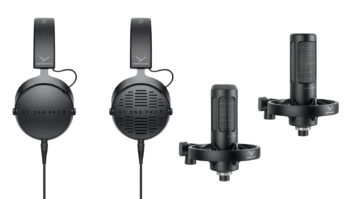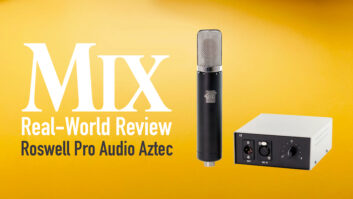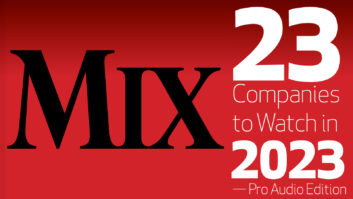A view inside Slate’s foxy box.Two channels and four distinct sounds: The versatile Fox slyly delivers a wider range of premium tones that you would normally expect from a 1U boutique preamp.

The reality of today’s studio environment is that we often want a single piece of equipment to cover a lot of territory, yet retain a high standard of quality. That reality reflects exactly how Slate Pro Audio’s Fox twochannel microphone preamplifier is designed; it’s a versatile preamp with four distinct sounds that hopefully emulate a small rack of gear.
Features
The American-built, solid-state Fox is actually quite straightforward. On the rear panel of this 1U unit are XLR mic inputs and outputs as well as quarter-inch TRS outputs for each channel. On the front panel, each channel has a single quarterinch Instrument input, a 12-position Grayhill milspec gold-plated rotary Gain switch with 5 dB steps (up to 60 dB) and an output control where the gain is at unity when fully counterclockwise. There’s a Pad switch (-10 dB), an Instrument/Mic switch, a polarity switch, Phantom Power switch (+48v), Signal Indicator LE D and single master power switch.
The preamp has two discrete, combinable circuits per channel selectable from Vintage/Modern or Normal/Combo. Vintage follows the “British Discrete Class-A” design and Modern is a “very precise, clean and detailed” sound; think Neve/API as Vintage and Grace/Millennia as Modern.
When selecting Combo mode, the input of one circuit is combined with the output of another. Therefore, Vintage/Combo send the input of the Vintage circuit to the output of the Modern one. Modern/Combo sends the input of the Modern circuit to the output of the Vintage one. With two simple switches, you essentially have four different sounds.
In Use
I took the Fox over to design engineer Vincent Miraglia’s studio, where he opened the top to check circuit topology. He noted the well-built linear power supply, which includes an AMGIS toroidal power transformer followed by solid-state rectification. He explained that toroids provide less audible hum, efficient operation and very low stray magnetic fields. He pointed out the Altran C-1408 input transformers and C-4000 gapped output transformers, which were being used with a 600-ohm secondary. He also noted that each channel used three Burr Brown OPA2604AP Dual FETInput low-distortion operational amplifiers.
The Fox handily features two instrument inputs on the front panel.All that is fine, but we needed to put it to the test on a real session. Since Miraglia is also a drummer and fellow composer, we started with a single beyerdynamic M160 in front of his kit. Running through each mode and recording a short example, we both heard exactly the same qualities: the Vintage circuit, which uses both an input and output transformer, was warm, classic and deep; and the Modern circuit, which uses all op-amps, is cleaner with a crisper top end. Each sounded very nice in its own way. Normal and Combo add subtle varieties to each of the above basic flavors. Vintage/Combo uses an input transformer and a transformerless output. Flipping that, with Modern/Combo, it’s a transformerless input with a transformer on the output.

Taking it home to my studio for additional overdubs, I first plugged in an Earthworks QTC-1 to record a pass with a nice Guild D-66 acoustic guitar. Starting with Modern/ Combo, I was amazed at the detail, clarity and depth; this mic and guitar pairing I’ve recorded literally hundreds of times, so I recognized that what I was hearing sounded really good (hear audioclip #1). Next, I switched over to Vintage/Normal and heard the change in character to a warmer, more “classic” sound (hear audioclip #2). Again, both were very pleasing.
Leaving it set to Vintage/Normal, I plugged in my ’70 Precision Bass to the quarter-inch input. After hitting a few notes, I was struck by the depth of the bass sound. Like my acoustic, I’ve recorded this instrument hundreds of times through a huge variety of DIs, but this sound hit me immediately. Just to make sure I wasn’t losing my mind, I plugged into two of my other preamps that I use for bass, and sure enough, the Fox was rounder and bigger. I then used an analyzer plug-in to look at the frequencies of each and it clearly had more presence in the 200-Hz area than my others; not the frequency I thought I heard differently.
Fox’s hefty 1U chassis is packed with premium quality components to provide “Modern” and “Vintage” tonal options.I tracked the bass part and didn’t add any EQ or compression; I wanted that big, dark John Paul Jones sound for this track. It was literally plug, play and mix (which I love for TV work). I also directly plugged in a Tele with P-90s to Vintage/Combo and was impressed with how warm the instrument sounded (and I hate DI sounds on a guitar). The overall feeling was that my instruments sounded so good, I was inspired to create with them. To me, that says it all.

Summary
The Fox is a good purchase for any home/ commercial studio owner looking to get a variety of sounds out of a single preamp. With a street price of just under $1,800, it’s not an inexpensive piece of gear. Yet considering it’s $900 per channel for a high-quality preamp with four distinct sonic styles make it a good deal all around. The bottom line: This unit sounds damn good, no matter how you slice it.
Price: $1,799 street
Contact: Slate Pro Audio | slateproaudio.com
Selected Audio Clips: Slate Fox
Visit the link below to hear audioclips from Rich’s Slate Fox evaluations, as noted in the review. — Ed.
prosoundnetwork.com/slatefox







